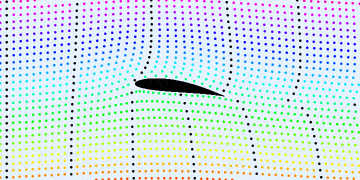

- About Us
- Outreach
- …
- About Us
- Outreach

- About Us
- Outreach
- …
- About Us
- Outreach

Home STEM Activities
Below are links to activities that have been developed and tested by Cornell scientists. They use common materials that students can find in their homes.

Air Pressure: Bernoulli's Principle
Students will learn about the principles of fluid dynamics to understand everyday phenomena such as how airplanes fly. (suitable for grades 3-8)
Concentration
Students will learn about what affects the concentration of a solution by detecting the amount of vanilla dissolved in water. (suitable for grades 3-9)
Crystal Growing: Homemade Rock Candy
Students will learn about how a solution changes through the crystallization of sugar and understand how temperature affects the ability of water to dissolve sugar (solubility). (suitable for grades 3-8)

Density Column
Students will explore density by creating a density column using different household liquids. They will add some simple materials to their column to estimate their densities.(suitable for grades 4-6)
Density of Coins
Students will use a ruler and a simple, home-built balance scale, to measure the mass and volume of coins and use this information to calculate the density. (suitable for grades 7-12)
Diffusion
Students will learn about diffusion and what factors can affect it with a few simple demonstrations. (suitable for grades 3-8)

Exploring Light
Students will use the light sensor in their phones, using a free app (Science Journal), to explore the properties of light with different materials. They will also learn how to use light to measure
concentration and estimate the concentration of juice in a mixture. (suitable for grades 6-12)Measuring Absorption Lesson Plan
Measuring Absorption Activity Sheet
Concentration of Juice Lesson Plan
Concentration of Juice Activity Sheet

Exploring Magnetism
Students will use the magnometer sensor in their phones, using a free app (Science Journal), to explore magnetism and to look at the relationship between magnetic force and distance. (suitable for grades 6-12)
Activity 2: What Materials are Magnetic?
Activity 3: Measuring Magnetism over Distance
Magnets and Magnetometer Reading

Exploring Newton's Laws of Motion
Students will use the accelerometer sensor in their phones, using a free app (Science Journal), to explore Newton’s Laws of Motion by measuring the acceleration of objects and
calculating the amount of force used to cause the motion. (suitable for grades 6-12)Activity 1: Accelerometer Intro
Newton's Laws of Motion Reading

Exploring Sound
Students will learn about the principles of sound, by constructing a speaker to amplify the sound and then to find a solution to reduce the perceived sound volume. (suitable for grades 5-9)
Newton's Laws of Motion Reading
Extracting DNA
Students will gain an understanding of the significance of DNA and will have the opportunity to observe it by extracting DNA from strawberries. (suitable for grades 5-12)

Glued into Science
Students will create different polymers through the process of cross-linking. They will then observe and test for the properties of these and other household plastics. (suitable for grades 5-12)

Nanomaterials: How to Stretch a 2-D Material
Students will learn about thin 2-D materials, like graphene, and make a stretchable in-plane spring out of a sheet of paper. They will then test how the number of cuts affects the stretchiness of the paper.(suitable for grades 4-12)

Non-Newtonian Fluids
Students will about the difference between Newtonian and non-Newtonian fluids. They will then observe the properties of a non-Newtonian fluid using cornstarch and water. (suitable for grades K-5)
Paper Bridges
Students will learn about the forces that act on a bridge and experiment to build the strongest bridge using a single sheet of paper. (suitable for grades K-8)
Physics of Bubbles
Students will gain an understanding of the significance of DNA and will have the opportunity to observe it by extracting DNA from strawberries. (suitable for grades 5-12)

Physics of Flight
Students can apply Bernoulli’s Principle by making paper helicopters and/or paper airplanes. They will learn about the forces that act on flight and experiment to test how a variable
affects flight. (suitable for grades 3-8)Paper Airplane Lesson Plan Paper Helicopter Lesson Plan
Paper Airplane Activity Sheet Paper Helicopter Activity Sheet
Reading: What Makes Paper Airplanes Fly?

Red Cabbage Chemistry
Students will learn about acids and bases by making an indicator solution with red cabbage and testing different household liquids to find out their pH. (suitable for grades 2-8)
Red Cabbage Indicator Activity Sheet
Tumeric Litmus Paper Activity Sheet
Presentation
Speed of Light
Students will gain an understanding of the significance of DNA and will have the opportunity to observe it by extracting DNA from strawberries. (suitable for grades 5-12)

Surface Tension
Students will investigate the a property of water called surface tension. They will build a simple boat that uses surface tension to propel itself. (suitable for grades K-8)

Static Sticky Tape
Students will use scotch tape to observe some of the properties of static
electricity. Older students can also explore how a variable might affectthe electrostatic force of the tape. (suitable for grades 3-12)












